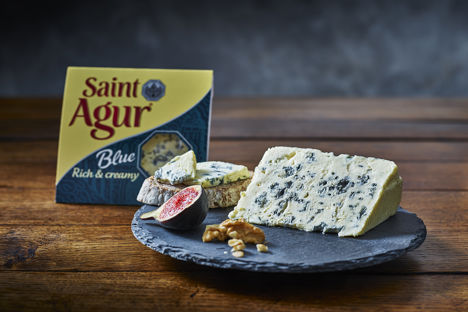
Saint Agur: blue gold from Auvergne
Matured in caves under the village of Beauzac, Saint Agur has quickly captured the hearts and minds of cheese-lovers in France and beyond. We go to the heart of Auvergne to find out what makes this blue cheese so beloved.
Saint Agur: blue gold from Auvergne
Matured in caves under the village of Beauzac, Saint Agur has quickly captured the hearts and minds of cheese-lovers in France and beyond. We go to the heart of Auvergne to find out what makes this blue cheese so beloved.
It’s hard not to be struck by the awe-inspiring beauty of Auvergne. This is an ancient, volcanic land, where the towering peaks of the Massif Central dominate the skyline, reaching up into the clouds then falling back down to lush green pastures and crystal-clear mirror lakes.
The petrified lava landscapes of the Parc Naturel Régional des Volcans d'Auvergne, and to the east, the Parc Naturel Régional Livradois-Forez, make for some of the most beautiful vistas in Europe. Thousands come to Auvergne every year to appreciate its natural beauty, but they also find a superbly rustic style of French cuisine that makes the most of exceptional local ingredients. Auvergne is home to some of the finest French foods: outstanding charcuterie, Puy lentils, cheesy aligot and Charolais beef, to name just a few. Head to the south of the region, however, and you’ll find one of Auvergne’s most prized treasures, tucked away in the Velay mountains – an intensely creamy blue cheese called Saint Agur.
Saint Agur doesn’t have the same centuries-old history that some other cheeses do (the cheese was developed back in 1988), but it’s a testament to its quality and flavour that it has already established itself as a beloved cheese both in France and further afield. Saint Agur was first made by the expert cheesemakers of the Velay mountains and to this day, every octagonal wheel of Saint Agur is made at the central fromagerie in Beauzac, using milk that comes from within a seventy-kilometre radius of the village.
The milk used to make Saint Agur comes predominantly from Montbéliarde cows, which are local to Auvergne’s Haute-Loire region. The lush green pastures the cattle feed on results in full-flavoured fresh milk, which is pasteurised before being coagulated, cut into curds and shaped into wheels by the cheesemakers. The wheels are then salted by hand and repeatedly pierced with needles, which allows the signature blue veins to develop courtesy of Penicillium roqueforti – the same fungus used to make Roquefort, Stilton and Cambozola.
From there, the cheeses go into maturation caves in Beauzac, where they spend the next ten weeks ripening. This is where the cheese becomes Saint Agur – whilst Roquefort and Stilton can be quite sharp and salty and Cambozola is quite mild, Saint Agur has a wonderful balance of intense blue cheese flavour and creamy, melt-in-the-mouth texture that’s created by the cool temperature and moist humidity of the caves.
It’s this balance that makes Saint Agur special. It has the piquancy that characterises good blue cheeses, but it isn’t overpowering. Instead of intense salinity there is a softer, more rounded fruitiness. It is tangy but not too acidic, with just enough sharpness to offset the creaminess.
Saint Agur comes in two different forms – the classic Saint Agur wedge and a soft, dippable Saint Agur crème. For the reasons above, Saint Agur is exceptionally versatile to cook with. Its high fat content means both the wedge and the crème spread and melt extremely well, which opens up a whole world of possibilities. You can crumble Saint Agur over a Croque Monsieur or a Welsh rarebit, for example, just before it goes under the grill, to give it an extra punch of tangy flavour. In fact, you can crumble Saint Agur over almost anything to give it an extra hit of salty, tangy, creamy flavour – our recipe for braised baby gem lettuce with peas and mint is taken to the next level by the late addition of some Saint Agur, and makes a brilliant side dish for roast beef or lamb.
Saint Agur crème is equally simple to use – you can stir it through pasta for a simple, delicious dinner for two, spread it over a crostini for a tasty snack or whisk it up with a bit of buttermilk and lemon juice to make an easy blue cheese dressing. Delicious as it is in its own right, it also makes a great base for other flavours – in the recipe for our rib-eye steak and blue cheese tacos, we combine Saint Agur crème with charred spring onions and sour cream to make a deep, earthy dressing that is sweet, salty, tangy and bitter all at once.
Saint Agur’s melting properties also mean you can easily incorporate it into batters and doughs. These Saint Agur gnudi are made with a mixture of Saint Agur and ricotta, resulting in light, fluffy dumplings with a rich, fruity blue cheese flavour. A similar technique works in these Saint Agur scones – the blue cheese flavour dissipates through the dough, and the resulting scones have a lovely flavour that goes perfectly with the fig relish and candied walnuts.
That piquancy, a hint of fruit and metallic tang is what makes blue cheese such a unique proposition for a chef – it’s not often you find an ingredient that goes as well with a flame-grilled steak as it does with a fig or a tray of roasted broccoli. Saint Agur really ticks all the boxes in that regard. Gone are the days when blue cheese was just for eating with a baguette – you can do so much more with Saint Agur.

